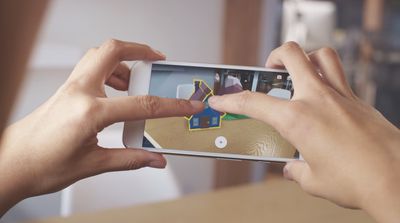Google today announced a new developer platform for augmented reality apps that won't require dedicated hardware, which it's calling "ARCore." The company originally began making inroads in the AR space a few years ago with Project Tango, which required manufacturers to implement specialized equipment so that smartphones would be compatible with Tango's AR features.
Now, Google is "effectively shuttering" the Tango brand, according to TechCrunch, and focusing on the ARCore software development kit. The new platform will deliver AR abilities to compatible Android smartphones, immediately turning a large swath of the Android device market into advanced AR-enabled machines, similar to what will happen with iOS 11-enabled devices following the debut of Apple's upcoming ARKit.

To start, ARCore is launching on the Google Pixel and Samsung Galaxy S8 (which must be running 7.0 Nougat or above), and a wider adoption of more smartphones will come later down the line for ARCore's public launch. By that date, Google "plans to have 100 million Android devices" out in the wild that support motion-tracking AR capabilities, and as more advanced smartphones launch the company said that ARCore will only grow stronger.
“We’ve architected ARCore to be able to perceive a wide variety of sensors,” Google AR/VR head Clay Bavor told TechCrunch. “We foresee, in the future, many more phones having depth-sensing capabilities and as those come into mainstream phones, that’s great, ARCore will work seamlessly with those and benefit from the additional sensing capabilities.”
ARCore works by detecting surfaces near the user in order to display augmented reality content in a stable space. The Android smartphone sensors will detect these horizontal planes, factor in the device's motion tracking, and estimate the light entering a room so objects can be dynamically lit based on their environment.
The company is also focusing on the web, which it describes as "a critical component of the future of AR." It's beginning by releasing a prototype browser for web developers, allowing them to begin experimenting with AR alongside mobile developers. In the future, Google says that these custom browsers will allow developers to make AR-enhanced websites that run on both Android and ARCore, as well as iOS and ARKit.
Apple announced ARKit back in June, introducing a developer platform that functions in much the same way as Google's ARCore. With ARKit, developers can create apps that take advantage of the built-in camera, processors, and motion sensors of an iPhone or iPad, resulting in advanced AR experiences. Demos of these apps have been continuously emerging online in the wake of ARKit's WWDC announcement.
Android developers interested in ARCore can begin experimenting and creating apps for the Pixel and Galaxy S8 smartphones starting today. To see more examples of ARCore in action, Google has created an AR Experiments website.
























Top Rated Comments
So, what happens to the software developers that invested their time (are therefore their money) in developing products based on Tango?
So, what happens to the device manufacturers (like Lenovo and Asus) that made phones and tablets, with expensive PrimeSense chips for the Tango platform? There's still devices to be sold to the costumers, how they are justifying the more expensive cost, to the common man in a store, now that Google made something that does everything Tango had, but for free?
100 million by the end of the year? Yeah, good luck, first, it requires nougat, second, crappy sensors will ruin this , third, most developers will want to reach more people and will use crappier SDKs that will work with more devices.
In any case, ARKit holds and advantage for now because it's specifically calibrated to Apple's sensors and hardware.
Gapplesung, Inc.
"At Gapplesung, we make the products, we may have thought of first."